This is the website of Abulsme Noibatno Itramne (also known as Sam Minter).
Posts here are rare these days. For current stuff, follow me on Mastodon
|
In the latest Curmudgeon’s Corner Sam and Ivan talk about:
* Sick Kid
* FIFA Scandal
* Election 2016
* Patriot Act Extension
* Lightning Round

Recorded 2015-05-28
Length this week – 1:27:42
 1-Click Subscribe in iTunes 1-Click Subscribe in iTunes
 View Podcast in iTunes View Podcast in iTunes
 View Raw Podcast Feed View Raw Podcast Feed
 Download MP3 File Download MP3 File
 Follow the podcast on Facebook Follow the podcast on Facebook
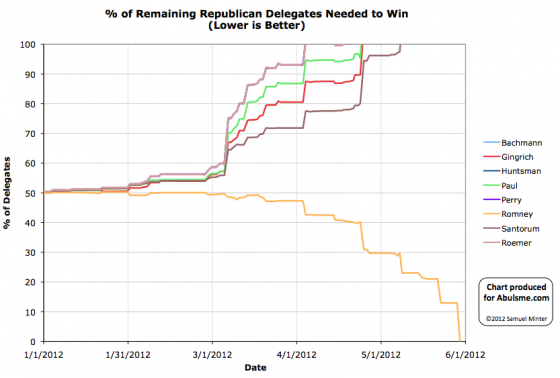
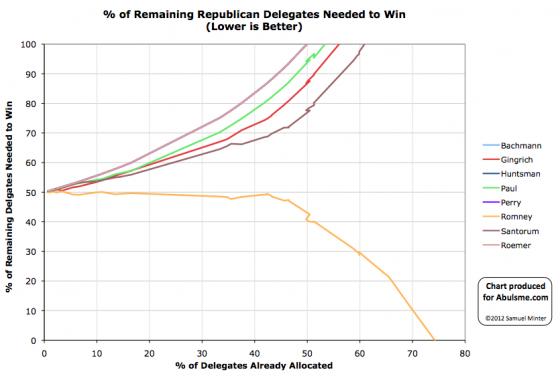
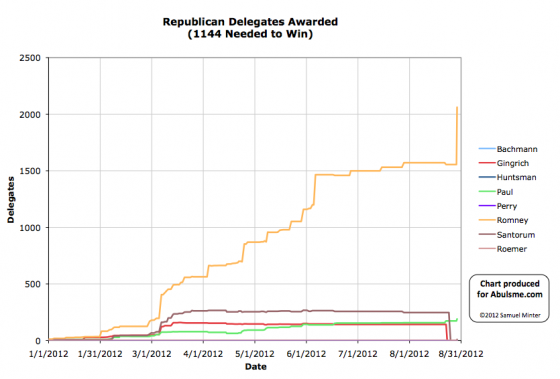
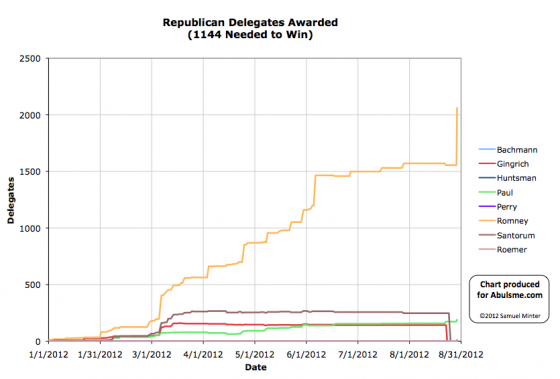
While there are still speeches yet to come, and a few more things my happen at the Republican National Convention, the actual nomination is now complete. The Republicans officially have a nominee. So time to review the final results of the delegate race.
| Stage |
Bachma. |
Gingri. |
Huntsm. |
Paul |
Perry |
Romney |
Santor. |
Roemer |
NV/U |
| Peak |
2 |
159 |
2 |
173 |
6 |
1571 |
268 |
0 |
|
| Final Est |
1 |
142 |
0 |
173 |
0 |
1555 |
247 |
0 |
168 |
| Roll Call |
1 |
0 |
1 |
190 |
0 |
2061 |
9 |
1 |
23 |
| Official |
0 |
0 |
0 |
0 |
0 |
2061 |
0 |
0 |
255 |
Peak represents the highest delegate estimate the candidate had during the primary season (not counting the final convention results).
The final estimates reflect the best estimates used here as of the “end” of the primary season. Specifically these is the estimate on August 22nd 2012, right before Gingrich and Santorum released their delegates. These released delegates were then free to vote for whoever they wanted in the Roll Call.
The roll call represents the count of the votes verbally given by the states at the Roll Call at the convention on August 28th 2012. (There were five votes in Pennsylvania that some reported as going to Paul Ryan, others have said the speaker said “Paul, Ron”. I believe these were intended for Ron Paul, so have counted them as such.)
The official count represents the vote as recorded by the convention. Romney was the only candidate who was officially nominated and seconded at the convention, so therefore was the only candidate who could officially receive votes and have them registered. Officially any votes for anybody else were equivalent to abstentions.
Lots more details on the final results of the full process can be found on the Results of the 2012 Republican Party presidential primaries page on Wikipedia, Green Papers (including totals), and DCW.
Note: Charts from the Abulsme.com 2012 Republican Delegate Count Graphs page. The first and second charts represent the % of remaining delegates the candidates needed in order to reach 1144 and win the nomination. Going above 100% represented being mathematically eliminated, dropping to 0% represented “clinching” the nomination. The first chart shows this by date, while the second shows this by % of the delegates determined so far. The third chart is the % of delegates the candidate has collected. The fourth is the actual number of delegates. These numbers include estimates of the eventual results of multi-stage caucus processes as those estimates were refined over time. The final data point represents the roll call count, not the official results which only counted votes for Romney.
[Edit 2012 Aug 29 14:59 to add two more charts and revise the final note.]
[Edit 2012 Aug 29 15:42 to add links to sources for more info.]
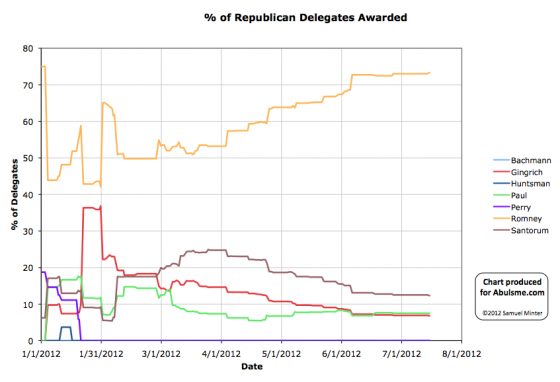
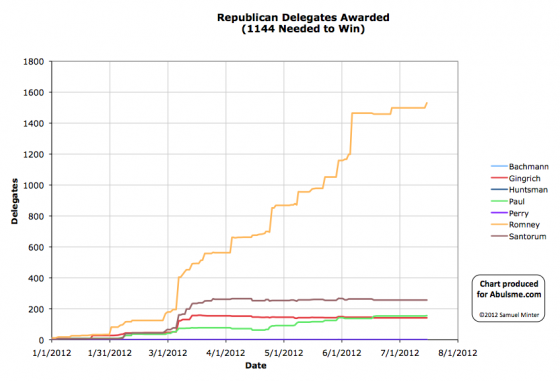
Charts from the Abulsme.com 2012 Republican Delegate Count Graphs page. The first chart is the % of delegates the candidate has collected, the second is the number of delegates. These numbers include estimates of the eventual results of multi-stage caucus processes which will be refined as the later stages occur.
And so, yesterday, on July 14th, Nebraska had their state convention. Nebraska ends up 32 Romney, 2 Paul, 1 TBD.
And with that, the last major scheduled event on the 2012 Primary calendar comes to a close.
We end up with: 1531 Romney, 257 Santorum, 156 Paul, 142 Gingrich, 1 Bachmann… and 199 TBD.
Of course at some point those 199 TBD’s have to make up their minds and vote for somebody at the convention (or abstain). And in all likelihood many of the non-Romney’s will end up voting for Romney after all. Or the convention may just have a motion to declare Romney the winner by acclimation and we may never get a full vote count. In previous years though, in the final roll call vote, the winner has gotten much more than their totals at the end of the primary season would indicate, and everybody else has gotten less.
Not to mention, to be officially nominated at the convention, you need to have won at least five state contests. So a quick look at that total:
- Romney – 41 contests (Most Places) plus 2 ties (Alaska, Mississipi)
- Santorum – 3 contests (Alabama, Kansas, Oklahoma) plus 2 ties (Alaska, Mississipi)
- Paul – 3 contests (Iowa, Maine, Minnesota)
- Gingrich – 2 contests (Georgia, South Carolina)
In Montana and Pennsylvania uncommitted delegates are in the plurality.
There is also Louisiana, where there is a lawsuit between the Romney and Paul people that leaves the final delegate winner still undetermined.
(These add up to more than 50 due to DC, Puerto Rico, Guam, American Samoa, etc.)
In any case, unless there are defections in those two tied states that let Santorum claim them, it looks like Romney is the only one eligible to even be nominated.
There may be additional delegate changes on the margin, but I believe this is the last “event” prior to the convention.
So there we are. I’ll update after the convention if an official final delegate vote count is released.
Edit 2012 Jul 16 16:52: It has been pointed out in several places that technically speaking that unlike the actual vote for the presidential nominee, the votes for the “plurality” needed to nominate are not bound in any state. So therefore even in states where Paul does not have a plurality of the delegates, if a plurality of the delegation wishes to put Paul in nomination they could. This is perhaps most relevant in the cases where the delegate count is bound by primary results, but Paul managed to get his supporters elected to the actual delegate slots. In these cases, those delegates might give their state a plurality in favor of nominating Paul, but then those delegates would still be required to vote for Romney when the actual vote for the nominee came up. This seems like it is unlikely to actually happen unless the Romney folks decide it is in their best interest to let it happen. Also mentioned frequently, is that there is no binding at all on the nominations or voting for Vice President. So, if Paul’s folks wanted to make a show of it and cause trouble, they could nominate Paul for VP, regardless of Romney’s stated preference for that spot, then force a vote on it. Romney’s choice would then win of course, but we’d have a little drama first.
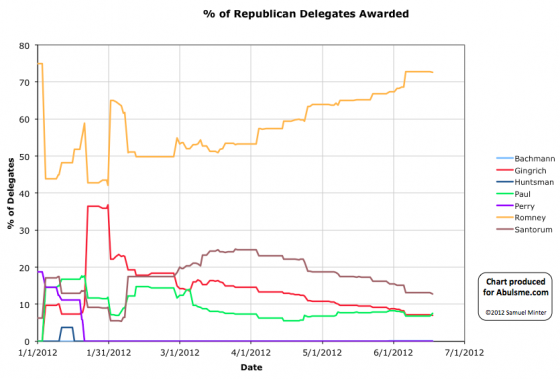
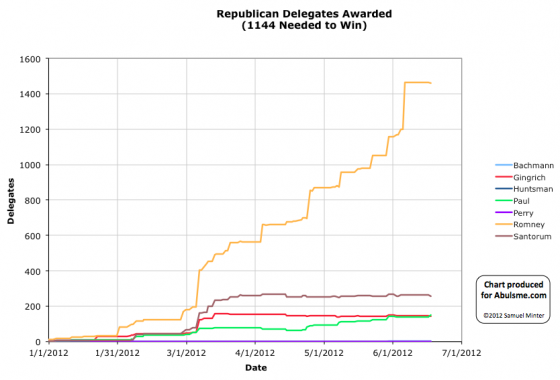
Charts from the Abulsme.com 2012 Republican Delegate Count Graphs page. The first chart is the % of delegates the candidate has collected, the second is the number of delegates. These numbers include estimates of the eventual results of multi-stage caucus processes which will be refined as the later stages occur.
Not that it matters at this point, but as the final results from Iowa came in this weekend, the results for Ron Paul were more favorable than the original estimates, so he gained delegates in my count, and the others lost delegates. The result is that Ron Paul has now passed Newt Gingrich for third place. (I use the Green Papers Soft Count, plus the DCW super delegate count in places where Green Papers hasn’t included them).
This of course doesn’t change the end results here at all. Romney is the nominee. It does however show once again how the final results in caucus states can be dramatically different from the “estimated” results based on the popular vote in caucus states. In the case of Iowa, the initial estimate was Romney 6, Santorum 6, Paul 6, Gingrich 4. As of right now we have Paul 21, TBD 7. Quite a bit different.
There are a lot of people who argue that because of these sorts of things, one should only look at the “hard” count of delegates actually already fully allocated and bound rather than trying to estimate caucus states at all in the early stages or the way some officially uncommitted delegates will go. I still think there is some value in doing those estimates, but one must be very aware of the limits of those estimates.
For reference, my current overall count is this:
Romney 1459, Santorum 257, Paul 152, Gingrich 142, Bachmann 1, TBD 275
Green Papers “Hard” Count has the following:
Romney 1329, Santorum 251, Gingrich 143, Paul 98, Huntsman 2, Bachmann 1, TBD 462
A little different. Either way though, Romney wins. :-)
Update 2012 Jun 17 23:36 UTC: Made my format for delegate counts consistant.
Update 2012 Jun 18 18:38 UTC: Minor wording fix.
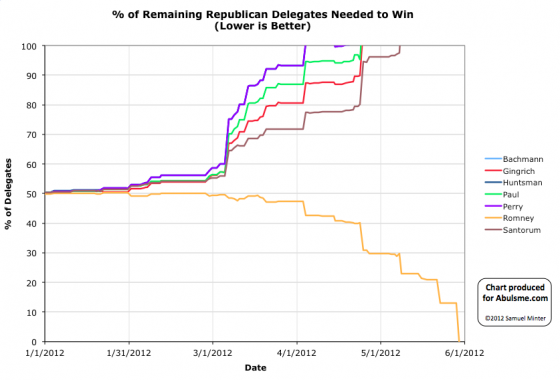
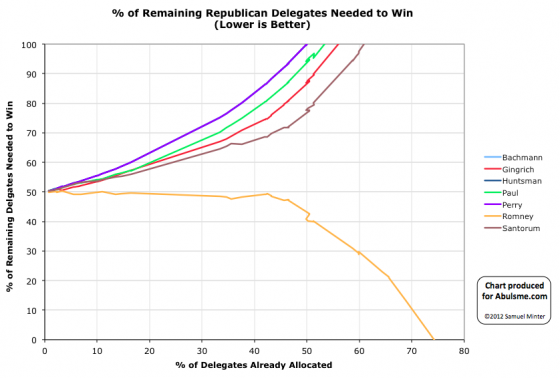
Charts from the Abulsme.com 2012 Republican Delegate Count Graphs page. When a candidate gets down to 0%, they have clinched the nomination. If they get above 100%, they have been mathematically eliminated. The first chart is by date, the second is by “% of Delegates Already Allocated”. These numbers include estimates of the eventual results of multi-stage caucus processes which will be refined as the later stages occur.
This is what we have been waiting for seemingly forever. By the beginning of March it was clear that no other candidate than Romney had the ability to get to 1144 absent a miracle. By the beginning of April it was clear that the non-Romney’s also were not going to be able to collectively block Romney absent a miracle. But Romney still needed to actually get to 1144. Slowly but surely he did so through April and May. Today he finally goes over the top. (At least with the count I use, which uses the Green Papers soft count plus the DCW Superdelegate Count. Other counts may differ.)
Since this is “the end” lets include a couple of additional graphs with two other views of the race:
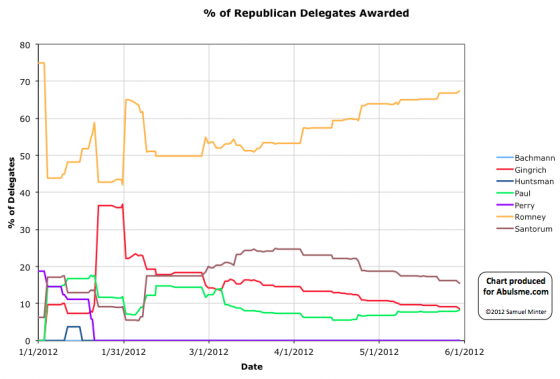
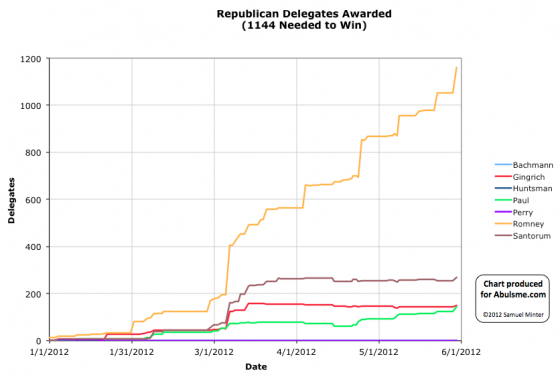
All of these charts show how Romney completely dominated this race from the very beginning. There was NEVER a point in the entire campaign where Romney was not ahead in delegates. It was only even close for a few days after Gingrich won South Carolina. The rest of the time, this whole campaign has just been a story of Romney slowly but surely pulling further and further ahead.
Now lets look specifically at today’s results from Texas.
Prior to today, none of Texas’s 155 delegates had been allocated. As of this update we have Romney 105, Paul 18, Santorum 13, Gingrich 7, Bachmann 2, TBD 10. Yes, that is right, at this late state, Michelle Bachmann mounts a comeback it seems. In any case, an overwhelming Romney win.
Romney also picked up two super delegates from Colorado today.
So net for the day: Romney +107, Paul +18, Santorum +13, Gingrich +7, Bachmann +2. Romney gets 72.8% of the delegates awarded today. This is way more than the 12.9% of the remaining delegates he needed to be on track to get to 1144 before “the end”. This was actually enough to push him over the edge.
My count now has the totals as: Romney 1159, Santorum 268, Gingrich 150, Paul 143, Bachmann 2
Now, by the Green Papers “hard count” that only counts delegates that are officially bound to Romney and theoretically have no discretion or ability to change their mind, we have Romney 1012, Santorum 245, Gingrich 143, Paul 93, Bachman 2, Huntsman 2… so by that count Romney still has a little bit further to go. The soft count also includes estimates for how delegates with discretion will vote and for how the remaining processes that are not yet final will play out. I also add in the super delegates who have publicly stated a preference. This is all reasonable. So I feel confident having using the count we have used all along, and considering Romney to have gotten to the 1144 magic number as of today.
Since we are hitting this major milestone today, I’ll take advantage of this time to highlight the comparisons with the 2008 races. More comparisons with 2008 can be found here.
First, to make comparisons easier, the 2012 race on a full 0%-100% scale:
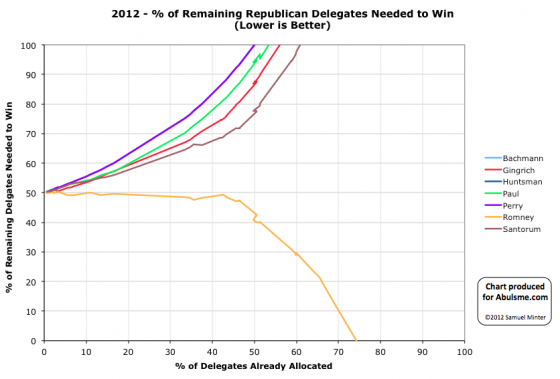
Then what the equivalent graph looked like in 2008:
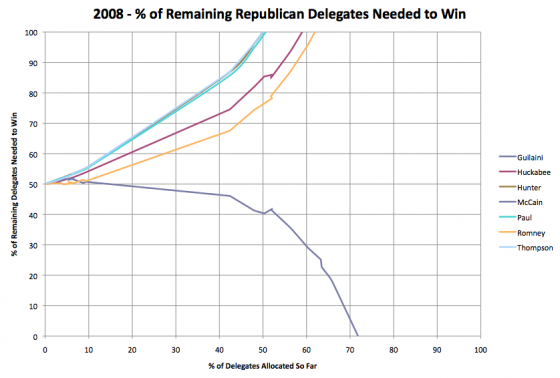
Looking at these two, in 2008 McCain had two non-trivial opponents compared to the 3 Romney had this time. In 2008, McCain pulled away from the other candidates starting around the 10% mark. In 2012 Romney was ahead from the very beginning. By the the 5% of delegates awarded mark (after Florida), Romney opened up the gap and none of the others ever came close again. Both Romney and McCain got to the “40% of remaining needed to win” mark at almost exactly the point where 50% of the delegates had been awarded. These two years look pretty similar.
Another view comparing Romney 2012 to McCain 2008 looks at % of total delegates earned by the eventual winner vs % of total delegates allocated. This was originally prompted by a post at Enik Rising. Looking at both candidates on the same chart we see this:
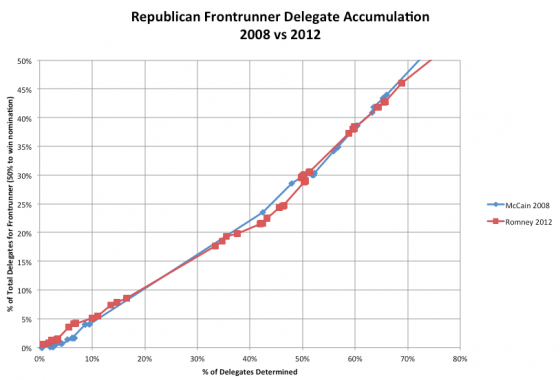
Despite all the talk at various points in time about Romney having problems closing the deal by comparison to 2008, this shows clearly that no such thing was happening. Any perception to that effect was due only to the fact that the calendar was more spread out this year than in 2008. Comparing the two curves, sometimes Romney was ahead, sometimes McCain was ahead, but for the most part these two lines tracked each other closely.
Finally, just for completeness, here is what an actually close race looks like on the “% of remaining delegates needed to win” chart… specifically, the Democrats in 2008:
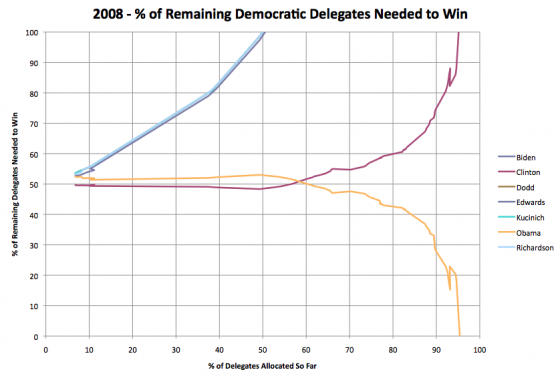
With that, we wrap up the regular coverage of the Republican delegate race for 2012. There may be additional updates for specific milestones… if Paul manages to pass Gingrich in the delegate count… the final totals once all the state delegate selection processes are actually over… or the final roll call count at the convention… but as for regular updates this is it.
Thanks for everybody who has been reading and enjoying these updates over the last five months.
From here on out, it is all about the Electoral College…
Edit 2012 Jun 5 12:49 UTC: Fixed affect/effect typo.
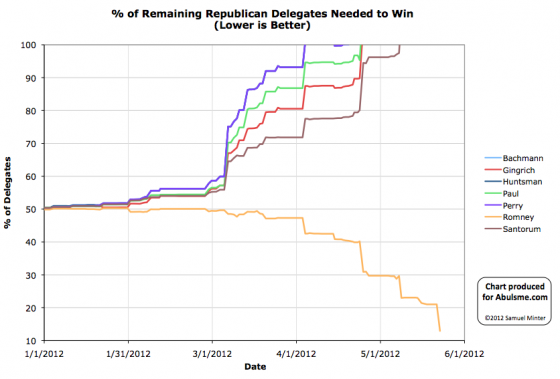
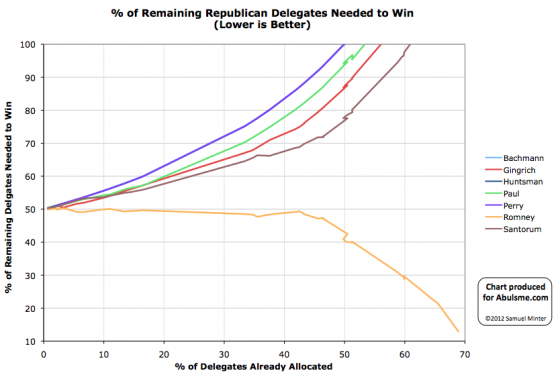
Charts from the Abulsme.com 2012 Republican Delegate Count Graphs page. When a candidate gets down to 0%, they have clinched the nomination. If they get above 100%, they have been mathematically eliminated. The first chart is by date, the second is by “% of Delegates Already Allocated”. These numbers include estimates of the eventual results of multi-stage caucus processes which will be refined as the later stages occur.
Updates for three states today.
First of all, Minnesota. The state convention was Friday and Saturday, but our source The Green Papers didn’t update their counts until a few hours after I did my daily scan of the delegate counts on Tuesday. I did my scan at 02:41 UTC yesterday, GP updated their counts sometime between then and 07:00 UTC. If I’d done my scan a little later as I sometimes do, this would have been its own update yesterday, but I didn’t, so it gets included in today’s update instead.
Regardless, based on the results of the state conventions, the estimates for Minnesota change. Previously, the estimates were Paul 24, Santorum 8, Romney 2, Gingrich 2, TBD 4. Now, after the convention: Paul 32, Santorum 2, Gingrich 1, TBD 5. Notice Romney now has no delegates in Minnesota at all. Wow. (Although some of the TBDs may go that way when they eventually choose.) Net for this update in Minnesota: Paul +8, Gingrich -1, Romney -2, Santorum -6. This would be great for Paul except for the fact that he is so far behind that it doesn’t matter. But fun stuff in Minnesota none the less.
Now we get to the two states that voted in primaries on Tuesday. Both are Romney shutouts.
Arkansas: Romney gains 33 delegates. New totals: Romney 35, TBD 1
Kentucky: Romney gains 42 delegates. New totals: Romney 42, TBD 3
So, the total take for the day: Romney +73, Paul +8, Gingrich -1, Santorum -6
New overall totals by our count: Romney 1052, Santorum 255, Gingrich 143, Paul 125.
Romney only needs 92 more delegates to win. That is 12.9% of the remaining delegates (down from 21.0% before today’s update).
Texas is Tuesday and has more than enough delegates to push Romney over the edge.
Tuesday should be it.
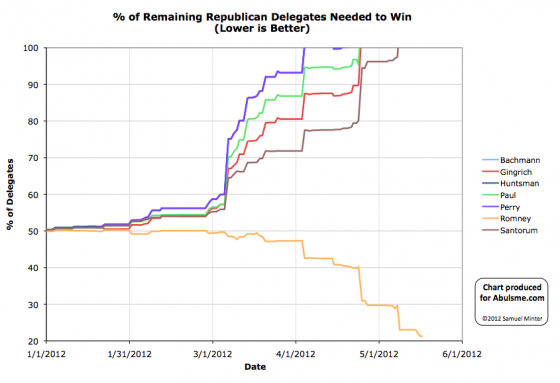
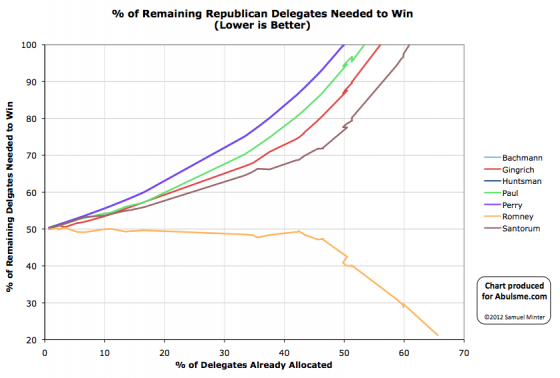
Charts from the Abulsme.com 2012 Republican Delegate Count Graphs page. When a candidate gets down to 0%, they have clinched the nomination. If they get above 100%, they have been mathematically eliminated. The first chart is by date, the second is by “% of Delegates Already Allocated”. These numbers include estimates of the eventual results of multi-stage caucus processes which will be refined as the later stages occur.
Today we have some updates to yesterday’s Oregon results.
First of all, it turns out Santorum gets one more delegate than it looked like yesterday, and Gingrich gets one less.
Second, the remaining two Oregon superdelegates stated they will echo the primary results and support Romney.
New summary for Oregon: Romney 21, Santorum 3, Paul 3, Gingrich 1
So net for the day: Romney +2, Santorum +1, Gingrich -1
So Romney’s % of remaining needed to win drops from 21.4% to 21.2%.
He needs 167 more delegates to get to the 1144 magic number by my estimate.
(My estimate uses the Green Papers Soft Count plus the DCW Superdelegate Count).
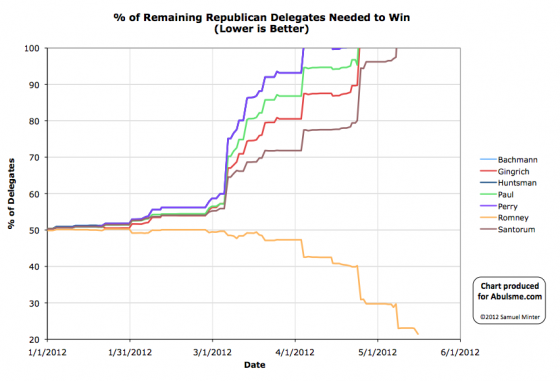
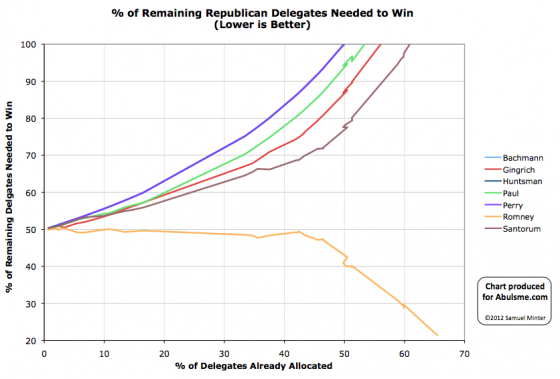
Charts from the Abulsme.com 2012 Republican Delegate Count Graphs page. When a candidate gets down to 0%, they have clinched the nomination. If they get above 100%, they have been mathematically eliminated. The first chart is by date, the second is by “% of Delegates Already Allocated”. These numbers include estimates of the eventual results of multi-stage caucus processes which will be refined as the later stages occur.
Today we have results from Oregon. Prior to today we had one superdelegate in Oregon for Romney and 27 TBD. We now have Romney 19, Paul 3, Santorum 2, Gingrich 2, TBD 2. So for the day Romney +18, Paul +3, Santorum +2, Gingrich +2.
Romney got 72.0% of today’s delegates, way more than the 23.0% he needed in order to be on track to clinch the nomination. So the march goes on.
Overall totals at this point: Romney 975, Santorum 260, Gingrich 145, Paul 117, TBD 789
I should also mention that a couple days ago Paul announced he would not be campaigning in the remaining primary states. Contrary to some of the headlines, he did not suspend his campaign like Santorum and Gingrich have. His campaign is still actively working the delegate process in the states where that is possible. He just isn’t dedicating any resources to trying to win votes in the remaining states where he has no chance of winning. Any efforts are concentrated on the actual process of delegate selection, which has basically been his strategy all along. Effectively though, by the nature of the memo the campaign put out, regardless of what was intended, the effect is that what little attention was still being given to him now fades away too. Especially since he also essentially promised to “behave” at the convention and not cause trouble.
So we now just wait for Romney to finish collecting the last 169 delegates he needs to win. Next up, Kentucky and Arkansas on the 22nd.
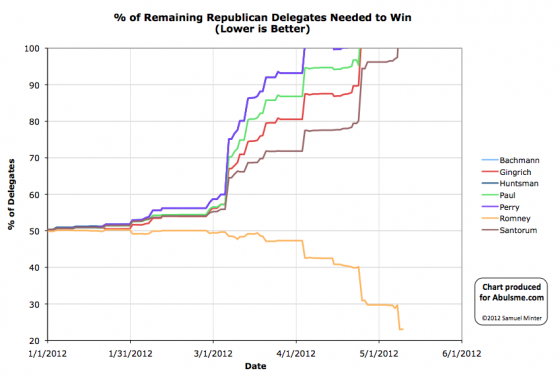
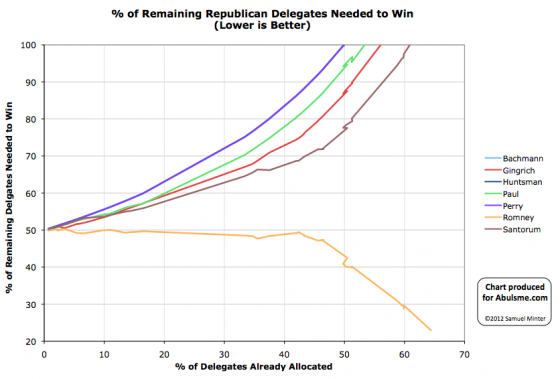
Charts from the Abulsme.com 2012 Republican Delegate Count Graphs page. When a candidate gets down to 0%, they have clinched the nomination. If they get above 100%, they have been mathematically eliminated. The first chart is by date, the second is by “% of Delegates Already Allocated”. These numbers include estimates of the eventual results of multi-stage caucus processes which will be refined as the later stages occur.
Very minor update today. One West Virginia delegate that was thought to be a Romney delegate turns out to really still be TBD. This makes the total in West Virginia: Romney 23, Santorum 2, TBD 6.
This in turn makes the overall total: Romney 956, Santorum 258, Gingrich 143, Paul 114, TBD 815
Romney’s “% of remaining needed to win” moves from 23.0% to 23.1%.
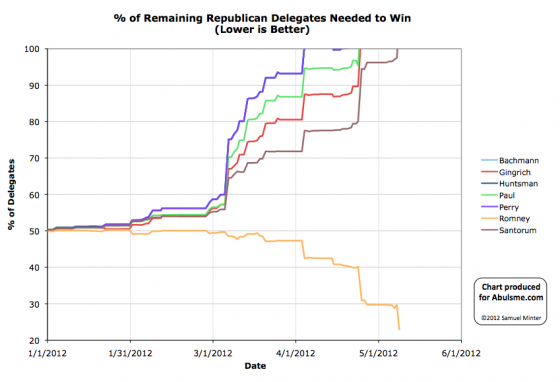
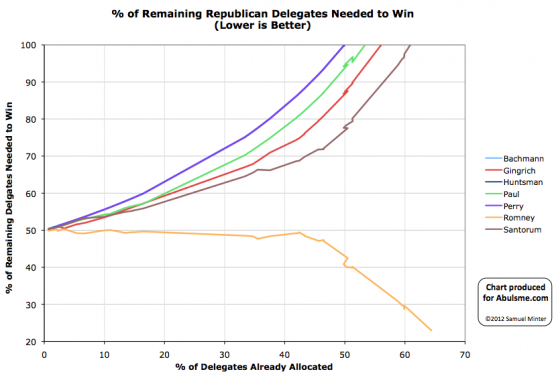
Charts from the Abulsme.com 2012 Republican Delegate Count Graphs page. When a candidate gets down to 0%, they have clinched the nomination. If they get above 100%, they have been mathematically eliminated. The first chart is by date, the second is by “% of Delegates Already Allocated”. These numbers include estimates of the eventual results of multi-stage caucus processes which will be refined as the later stages occur.
Yawn! This is so past over it isn’t funny, but I’ll be doing these posts until Romney gets to 1144!
Anyway, the new delegates awarded tonight are:
- North Carolina – Romney 36, Santorum 6, Paul 6, Gingrich 4
- Indiana – Romney 27
- West Virginia – Romney 22, Santorum 2
So that makes the total for today Romney 85, Santorum 8, Paul 6, Gingrich 4.
Hmm. Wonder who won tonight?
With 82.5% of the delegates, Romney did way better than the 29.7% of the delegates he needed to continue on pace for clinching the nomination.
Meanwhile, Santorum finally reached the point where even if he got 100% of the remaining delegates he could not catch up and win.
So now there is only one. But Romney still has to finish mopping up the delegates.
He now only needs 23.0% of the delegates that are left in order to get to 1144. Next up is Oregon on the 15th. Then Kentucky and Arkansas on the 22nd. Then Texas on the 29th. Texas will probably be the state that puts Romney over the top unless he does much worse than expected between now and then.
|
|
![]() 1-Click Subscribe in iTunes
1-Click Subscribe in iTunes![]() View Podcast in iTunes
View Podcast in iTunes![]() View Raw Podcast Feed
View Raw Podcast Feed![]() Download MP3 File
Download MP3 File![]() Follow the podcast on Facebook
Follow the podcast on Facebook

























